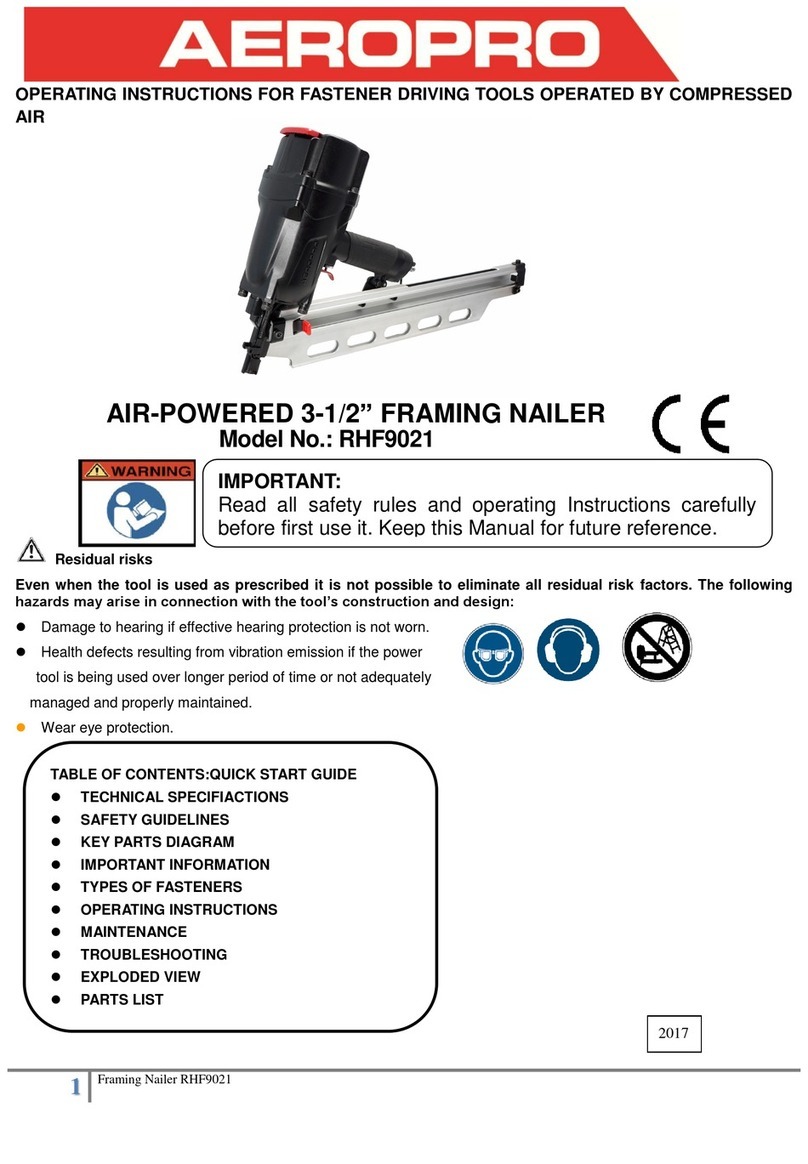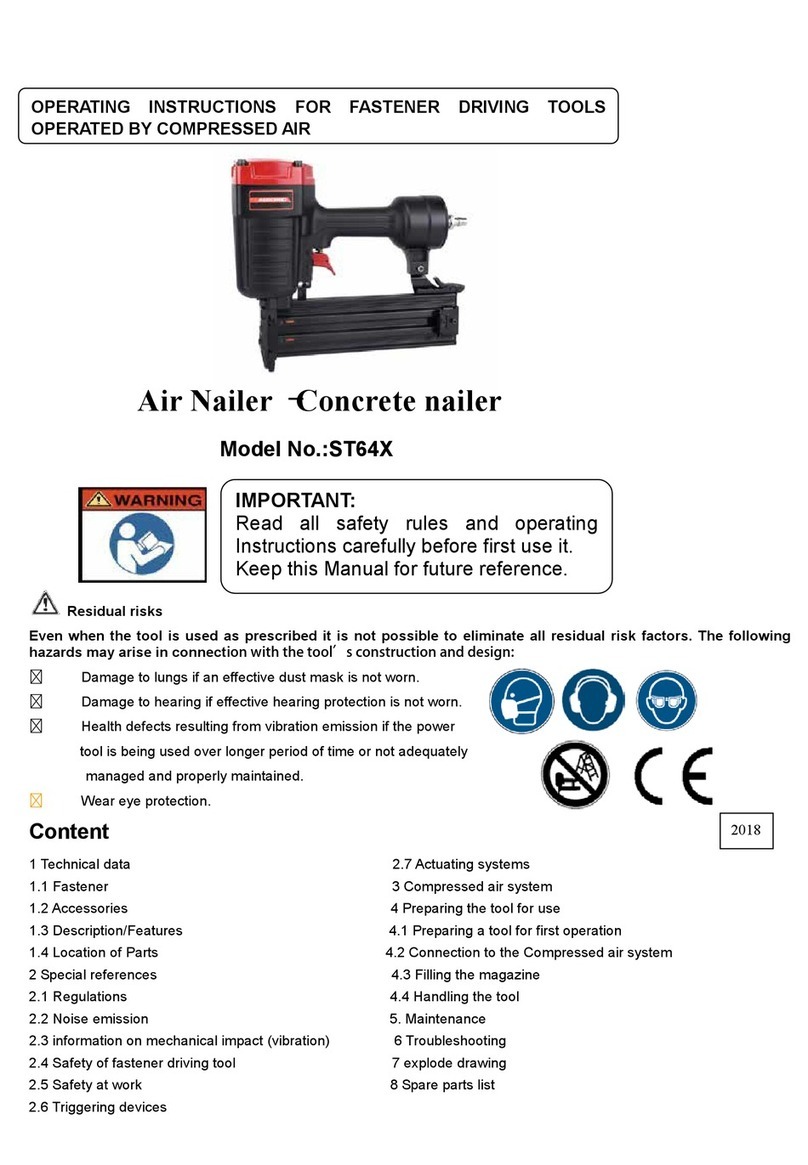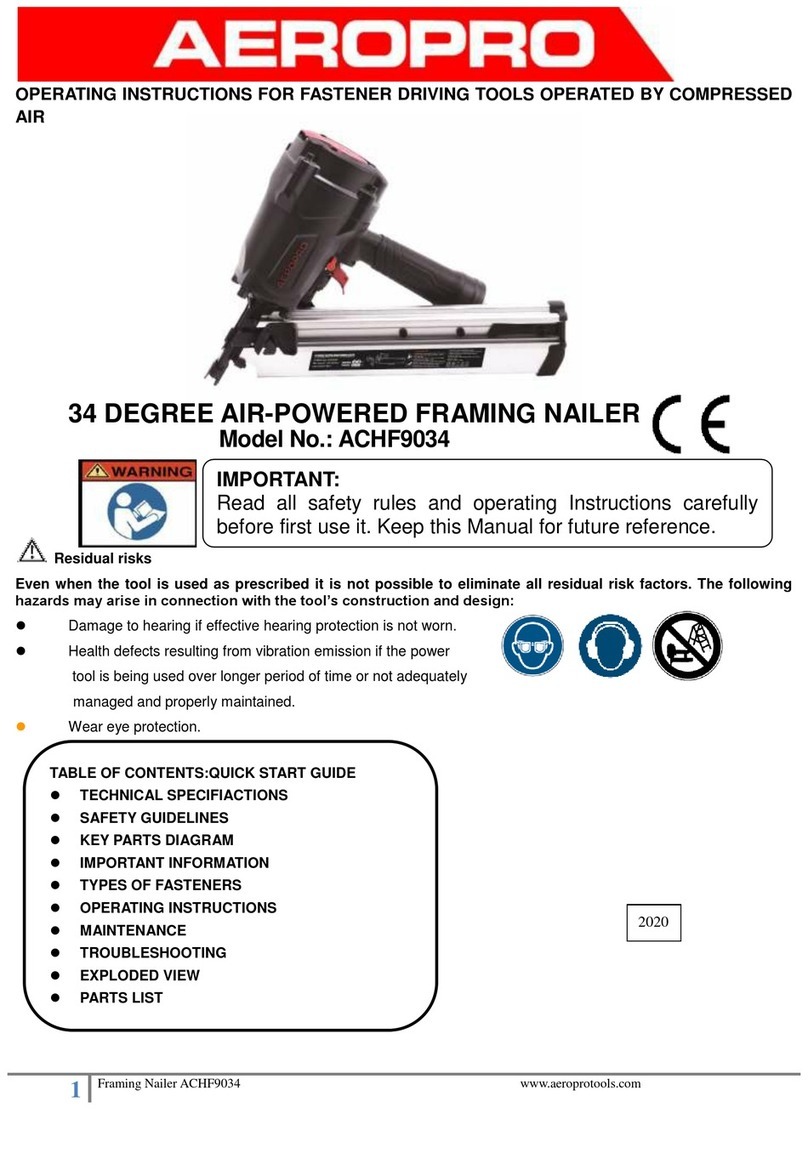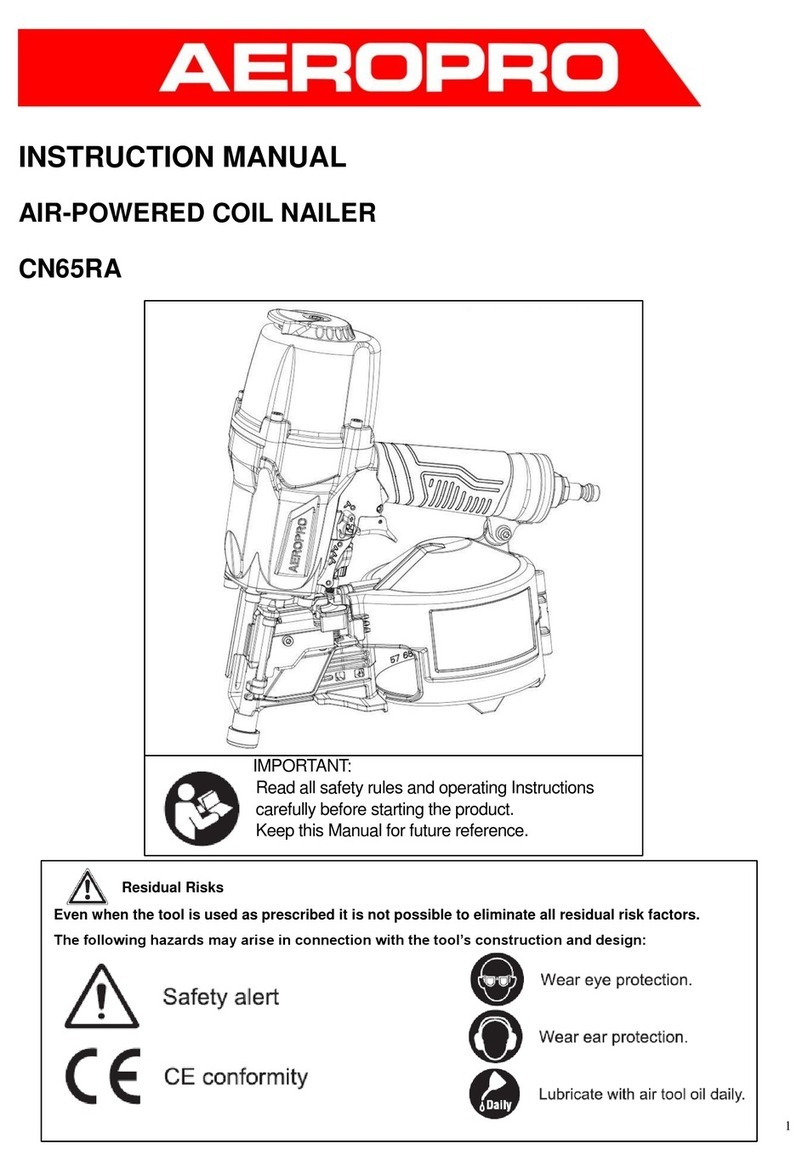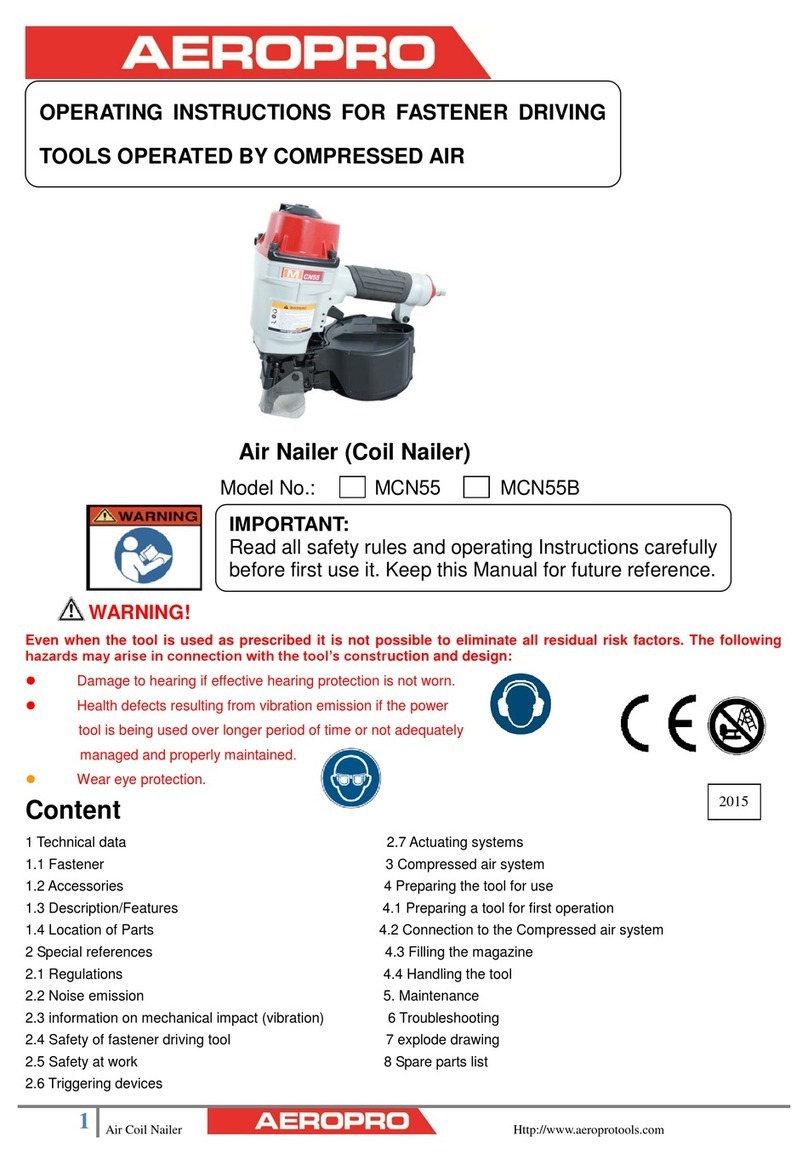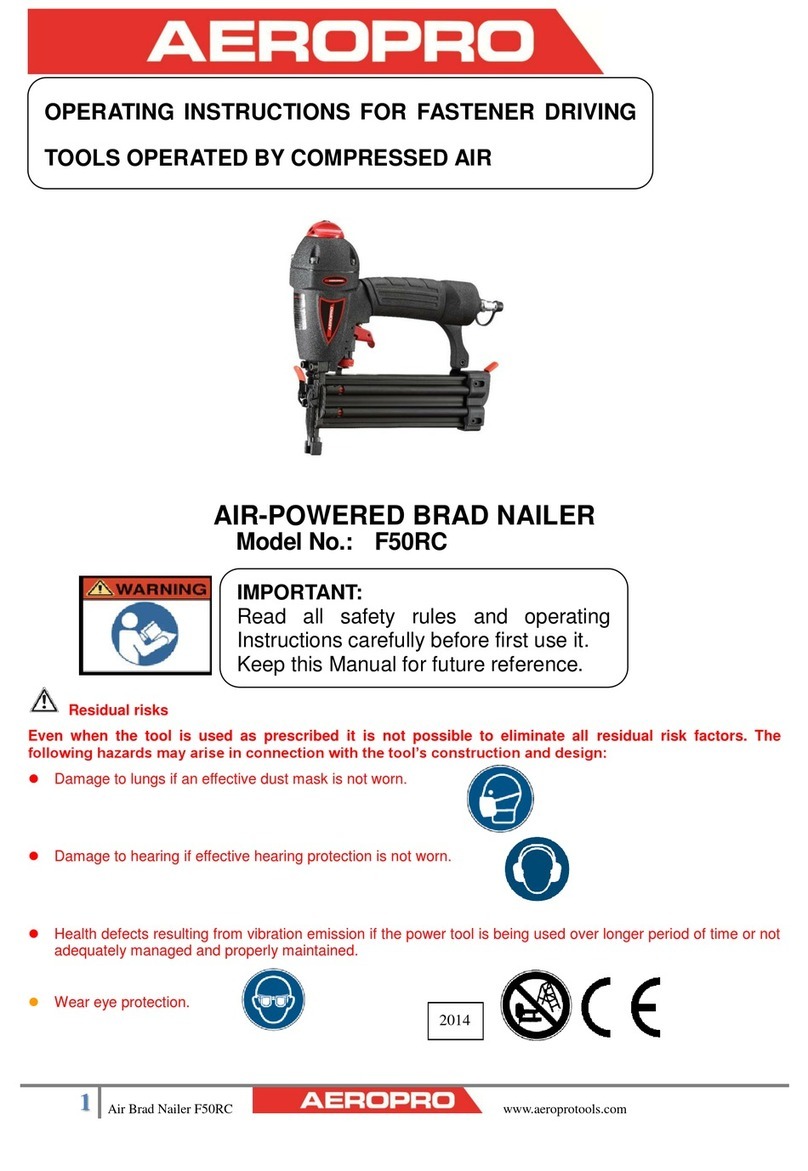Aeropro DA64R User manual

Angle Finish Nailer DA64R Http://www.aeroprotools.com 1
Operating Instruction
and safety manual
34°Angle Finish Nailer
Model: DA64R
1.Air Inlet Coupler 2. No-mar pad
3. Exhaust cap 4. Air Supply
5. Nails 6.Pusher
7.Magazine 8.Trigger
9.Depth adjustment knob 10.Safety yoke
11.Jam release
IMPORTANT:
Please read and fully understand this manual for informa�on rela�ng to protec�ng your
safety and preven�ng equipment problems.
And retain this manual for future reference.
DESCRIPTION

Angle Finish Nailer DA64R Http://www.aeroprotools.com 2
GENERAL SAFETY RULES
For muple hazards, read and understand the safety instruons before installing, operang, repairing, maintaining, changing
accessories on, or working near the air tool. Failure to do so can result in serious bodily injury.
Only qualied and trained operators should install, adjust or use the air tool.
Do not modify this air tool. Modions can reduce the eecveness of safety measures and increase the risks to the oper ator.
Do not discard the safety instruons; give them to the operator. Do not use the air tool if it has been damaged.
Tools shall be inspected periodically to verify that the rangs and markings required by this part of EN 792-13 are legibly marked on
the tool. The employer/user shall contact the manufacturer to obtain replacement marking labels when necessary.
PROJECTILE HAZARDS
Be aware that the failure of the work piece, or accessories, or even of the fastener driving tool itself, can generate high-velocity
projeces.
Always wear impact-resistant eye pron during the operaon of the air tool. The grade of pron required should be
assessed for each use.
Ensure that the work piece is securelyed.
ENTANGLEMENT HAZARDS
Choking, scalping and/or lacerans can occur if loose clothing, personal jewellery, neck wear, hair or gloves are not kept away
from the tool and accessories.
OPERATING HAZARDS
Operators and maintenance personnel shall be physically able to handle the bulk, weight and powerof the tool.
Hold the tool correctly; be ready to counteract normal or sudden movements and have both hands available.
Maintain a balanced body poson and secure foong.
Release the start-and-stop device in the case of an interrupon of the compressed air supply.
Use only lubricants recommended by the manufacturer.
Personal protecve safety glasses shall be used; suitable gloves and prove clothing are recommended.
REPETITIVE MOTIONS HAZARDS
When using an air tool to perform work-related acves, the operator canperience discomfort in the hands, arms, shoulders,
neck or other parts of the body.
While using an air tool, the operator should adopt a comfortable posture while maintaining a secure foong and avoiding awkward
or o-balanced postures. The operator should change posture durinended tasks, which can help avoid discomfort and fa
If the operator eperiences symptoms, such as persistent or recurring discomfort, pain, throbbing, aching, ngling, numbness,
burning sensans or sness, these warning signs should not be ignored. The operator should tell the employer and consult a
qualied health professional.
ACCESSORY HAZARDS
Disconnect the air tool from the compressed air line beforeng or changing the fasteners or accessory.
Use only sizes and types of accessories and consumables that are recommended by the air tool manufacturer; do not use other
types or sizes of accessories and consumables.
WORKPLACE HAZARDS
Slips, trips and falls are major causes of workplace injury. Be aware of slippery surfaces caused by the use of the tool and also of
trip hazards caused by the air line.
Proceed with care in unfamiliar surroundings. There can be hidden hazards, such as electricity or other uy lines.
The air tool is not intended for use in potenally eplosive atmospheres and is not insulated against coming into contact with
electric power.
Ensure that there are no electrical cables, gas pipes, etc., that can cause a hazard if damaged by use of the tool.
NOISE EMISSION
The characterisnoise values for the fastener driving tool have been determined in accordance with EN12549:1999 and EN ISO4871
"Acouscs-Noise test code for fastener driving tools-Engineering method”(see specicans).These values are tool-related characterisc
values and do not represent the noise development at the point of use. Noise development at the point of use will forple depend
on the working environment, the work piece, the work piece support, the number of driving operations, etc. Depending in the
condons at the workplace and the form of the workplace, individual noise aenuan measures may need to be carried out, such as
placing work pieces on sound-damping supports, prevenng work piece vibraon by means of clamping or covering, adjusng to the
minimum air pressure required for the operaon
involved, etc.
In special cases it is necessary to wear hearing pron equipment.
INFORMATION ON MECHANICAL IMPACT (VIBRATION)

Angle Finish Nailer DA64R Http://www.aeroprotools.com 3
The characteris vibraon values for the fastener driving tool have been determined in accordance with ISO 8662-11:1999 and EN
12096 ¨C Measurement of vibraon in hand-held power tools - Part 11: Fastener driving tools(see specions).
This value is a tool-related characterisc value and does not represent the inuence to the hand-arm-system when using the tool. An
inuence to the hand-arm-system when using the tool will for example depend on the gripping force, the contact pressure force, the
working direon, the adjustment of compressed air supply, the workplace and the work piece support.
ADDITIONAL SAFETY INSTRUCTIONS FOR PNEUMATIC POWER TOOLS
Air under pressure can cause severe injury.
Always shut oair supply, drain hose of air pressure and disconnect tool from air supply whenever not in use, before changing
accessories or where making repairs.
Never direct air at yourself or anyone else.
Whipping hoses can cause severe injury. Always check for damaged or loose hoses and ngs.
Cold air should be directed away from the hands.
Whenever universal twist couplings(claw couplings) are used, lock pins shall be installed and whip check safety cables shall be used
to safeguard against possible hose-to-tool and hose-to-hose connen failure.
Do not exceed the maximum air pressure stated on the tool.
Never carry an air tool by the hose.
Only fasteners listed in the specicans may be used in the fastener driving tool. The fastener driving tool and the fasteners
specied in the specicans are to be considered as one unit safety system.
Quick acn couplings shall be used for conneon to the compressed air system and the non-sealable nipple must be ed at the
tool in such a way that no compressed air remains in the tool adisconnecn.
Oxygen or combusble gases shall not be used as an energy source for compressed air operated fastener driving tools.
Fastener driving tools shall only be connected to an air supply where the maximum allowable pressure of the tool canno t be
exceeded by more than 10%; in the case of higher pressure ,a pressure reducing valve which includes a downstream safety valve
shall be built into the compressed air supply.
Only the main energy and the lubricants listed in the operang instruons may be used for the maintenance of fastener driving
tools. Only spare parts specied by the manufacturer or his authorised representave shall be used.
Repairs shall be carried out only by the manufacturer's authorized agents or by other experts, having due regard to the
informan given in the operang instruons.
Stands for mounng the fastener driving tools to a support, for example to a work table, shall be designed and constructed b y the
stand manufacturer in such a way that the fastener driving tools can be safelyed for the intended use, thus for example
avoiding damage, distoon and displacement.
Check prior to each operaon that the safety and triggering mechanism is funoning properly and that all nuts and bolts are right.
Do not carry out any aons to the fastener driving tool.
Do not disassemble or make inoperave any parts of the fastener driving tool such as the safety yoke.
Do not perform any ¡°emergency repairs¡± without proper tools and equipment.
The fastener driving tool should be serviced properly and at regular intervals in accordance with the manufacturer¡¯s instruons.
Avoid weakening or damaging the tool, for example by:
-punching or engraving;
-modion not authorized by the manufacturer;
-guiding against templates made of hard material such as steel;
-dropping or pushing across theor;
-using the tool as a hammer;
-applying excessive force of any kind.
Never point any fastener driving tool at yourself or at any other person or animal.
Hold the fastener driving tool during the work operaon in such a way that no injuries can be caused to the head or to the body in
the event of possible recoil consequent upon a disrupon in the compressed air supply or hard areas within the workplace.
Never actuate the fastener driving tool into free space. This will avoid any hazard caused by freeng fasteners and excessive
strain of the tool.
The tool shall be disconnected from the compressed air system for the purpose of transportaon, especially where ladders are
used or where an unusual physical posture is adopted whilst moving .
Carry the fastener driving tool at the workplace using only the handle, and never with the trigger actuated.
Take condons at the workplace into account. Fasteners can penetrate thin work pieces or slip ocorners and edges of
workplaces, and thus put people at risk.
For personal safety, use proteve equipment such ad hearing and eye pron.
Fastener driving tools are operated by actuang the trigger using nger pressure.

Angle Finish Nailer DA64R Http://www.aeroprotools.com 4
In addon, fastener driving tool isd with a safety yoke which enables the driving operaon to be carried out only the safety
yoke of the tool is pressed against a work piece, These tools are marked with an inverted triangle ▽behind the serial number and are
not permied for use without an eecve safety yoke. A safety yoke is not required on fastener driving tools which accelerate the
heaviest usable fasteners to a free ght velocity below an admissible risk of injury. Those fastener driving tools are not marked with an
inverted triangle.
SAFETY INSTRUCTIONS FOR COMPRESSED AIR SYSTEM
Proper funoning of the fastener driving tool requires ered, dry and lubricated compressed air in adequate quanes.
If the air pressure in the line system exceeds the maximum allowable pressure of the fastener driving tool, a pressure reducing
valve followed by a downstream safety valve shall addonally bed in the supply line to the tool.
The compressor plant shall be adequately dimensioned in terms of pressure output and performance(volumetric ow) for the
consumpon which is to be expected. Line seons which are too small in relan to the length of the line(pipes and hoses) , as
well as overloading the compressor, will result in pressure drops.
Permanently laid compressed air pipelines should have an internal diameter of at least 19 mm and a corresponding large diameter
where relavely long pipelines or muple users are involved.
Compressed air pipelines should be laid so as to form a gradient (highest point in the direon to the compressor ). Easily
accessible water separators should be installed at the lowest points.
Junons for users should be joined to the pipelines from above,
Conneng points for fastener driving tools should beed with a compressed air servicing unit (er/water separator/oiler)
directly at the junon point.
RESIDUAL RISKS
Even if you are operang this product in accordance with all the safety requirements, potenal risks of injury and damage remain. The
following dangers can arise in conneon with the structure and design of this product:
1. Health defects resung from vibraon and noise emission if the product is being used over long periods of me or not adequately
managed and properly maintained.
2. Injuries and damage to property due to fasteners or the sudden impact of hidden objects during use.
3. Danger of injury and property damage caused by ying objects.
FASTENER
TOOL
Nail type
Magazine capacity
100pcs
Air inlet size
1/4”(6.35mm)
Air hose size
3/8”(9.52mm)
Max working pressure
120PSI(8.3bar)
Working pressure range
80-120PSI(5.5-8.3bar)
Exhaust
Rear adjustable(360
°
)
Tool weight(no nails)
2.09kg(4.6lb)
SYMBOLS
SPECIFICATIONS

Angle Finish Nailer DA64R Http://www.aeroprotools.com 5
PREPARING THE TOOL FOR USE (See figure1)
Under normal use condons, the tool should be lubricated with air tool oil before connecng the tool to an air supply. dai ly with
minimal use, or twice a day with heavy use. Only a few drops of oil at a e is necessary. Too much oil will only collect inside the tool
and will be noeable in the exhaust cycle. Before connecng the tool, check the air compressor gauge to be sure it is funoning within
the proper range
NO-MAR PAD (See figure 2)
The no-mar pad aached to the safety yoke of the tool helps prevent marring and denng when working with so woods.
The pad can be removed by pulling it down and away from the safety yoke. To replace the pad, it into place over the safety yoke and
push up at the back to reseat.
ADJUSTING THE EXHAUST (see figure 3)
The adjustable exhaust on the end cap of the tool allows the operator to direct the exhaust according to operator preference. To adjust,
turn the exhaust cap in the desired direon.
CONNECTING THE TOOL TO AN AIR SUPPLY (see figure 4)
This tool is designed to operate on clean, dry compressed air at regulated pressures between 5.5 - 8.3 bar (80 – 120psi). The correct air
pressure is the lowest pressure that will do the job.
NOTE: Air pressure that is higher than 8.3Bar (120psi)may damage the tool.
The tool and air hose must have a hose coupling that allows all pressure to be removed from the tool when the coupling is disconnected.
Connect the tool to the air supply with a 1/4 in. female quick connector. For maximum tool performance, a 3/8 in. supply line andng
are required.
LOADING THE TOOL WITH FASTENERS (see figure 5-6)
1. Connect the tool to the air supply.
2. With the safety yoke of the tool pointed away from you, feed a strip of fasteners into the magazine. Be sure the fasteners are pointed
downward and at the angle shown.
3. Slide the pusher all the way to the rear of the magazine.
4. Release the pusher and allow it to push the fasteners to the driving mechanism. The pusher will stop when it rests against the end of
the fastener strip.
NOTE: Do not allow the pusher to snap back into place.
DRIVING A FASTENER (see figure 7)
Avoid triggering the fastener driving tool if the magazine is empty.
Any defecve or improperly funoning fastener driving tool must immediately be disconnected from the compressed air supply and
passed to a specialist for inspeon.
In the event of longer breaks in work or at the end of the working shi, disconnect the tool from the compressed air supply and it is
recommended to empty the magazine.
The compressed air connectors of the fastener driving tool and the hoses should be protected against contaminan, the ingress of
coarse dust chips, sand, etc, will result in leaks and damage to the fastener driving tool and the couplings.
Single sequential actuation mode
The tool employs single sequenal actuan mode.
1. Connect the tool to the air supply. 2. Grip the tool rmly to maintain control. Poson the safety yoke of the tool onto the work
surface.3. Push the tool against the work surface to depress the safety yoke.4. Squeeze the trigger to drive a fastener.5. Allow the tool
to recoil away from the work surface as the fastener is driven.
6. Always remove your nger from the trigger aer the fastener has been driven.
NOTE: If there is only one nail lein the magazine, it may not be fully driven into the workpiece, may be bent or fall out.
SETTING THE AIR PRESSURE
Having checked that the fastener driving tool is funoning correctly, apply the tool to a work piece and actuate the trigger.
Check whether the fastener has been driven into the work piece in accordance with the requirements.
If the fastener is protruding, increase the air pressure in increments of 0.5 bar, checking the result aer each new adjustment;
NOISE AND VIBRATION
INTENDED USE
Noise according to EN 12549:1999 and EN ISO 4871
The tool can be used for the purposes listed below:
A-weighted sound pressure level
LPA=91.1dB(A),KPA=2.5dB
Finish and trim(Interior and exterior),Door and
window architraves and moulding, Door jambs,
Skirng boards, Crown mouldings, Fascia boards,
Staircases, Hardwood ooring, Panelling and lining,
Shelving.
Sound power level
LWA=104.1dB(A),KWA=2.5dB
C-weighted sound pressure level
LPC=119.5dB(A),KPC=2.5dB
Vibon according to ISO 8662-11:1999
Vibon in the handle
W=2.14m/s
²
K=2m/s
²

Angle Finish Nailer DA64R Http://www.aeroprotools.com 6
If the fastener is driven into an excessive depth, reduce the air pressure in increments of 0.5 bar un the resu is sasfactory.
It is preferred to adjust the depth adjustment knob to reach the good fastening eect.
Work with theowest possibe air pressure. This w give you three signint advantages:
1. Energy wibe saved,
2. Less noise wibe produced,
3. A reduon in fastener driving tooear wibe achieved.
The amount of air pressure required widepend on the size of the fastener and the workpiece mate
Begin tesng the depth of drive by driving a test fastener into the same type of workpiece mate used for the actu job.
Drive a test fastener with the air pressure set at 6.2 - 6.5 (90-95psi).Raise or wer the air pressure tond theowest seng that w
perform the job with consistent resus.
It may be possibe to achieve the desired depth with air pressure adjustments ane. If ner adjustments are needed, use the drive
depth adjustment on the too
DRIVE DEPTH ADJUSTMENT(see figure 8)
The driving depth of the fastener may be adjusted. It is advisabe to test the depth on a scrap workpiece to determine the required
depth for the appcan. To determine depth of drive, st adjust the air pressure and drive a test fastener. To achieve the desired
depth, use the drive depth adjustment on the too
1. Disconnect the toohe air suppy.
2. Turn the depth adjustment knob or right to change the driving depth.
3. Reconnect the tooto the air suppy.
4. Drive a test fastener each adjustment un the desired depth is set.
REMOVING FASTENERS FROM THE TOOL(see figure 9)
1. Disconnect the toohe air suppy.
2. To remove a strip of fasteners from the too retract the pusher un it reaches the end of the magazine .Hod the pusher in pe.
NOTE: ways keepngersear of fastener track of magazine to prevent injury from unintended reease of the pusher.
3. Ti the tooup so that the hose connector faces down. Press the pusher buon and sowy reease the pusher to the front of the
magazine. The strip of fasteners wi sback un it reaches the stopper.
4. Press the stopper and the fasteners exit the rear of the magazine.
CLEARING A JAMMED FASTENER(see figure 10)
If a fastener becomes jammed in the too disconnect the air hose and keep the toopointed away from you whe cearing the jam.
1. Disconnect the toohe air suppy.
2. Remove fasteners from the too
3. Pu up on theatch and open the jease.
4. Insert a t bde screwdriver into the driving mechanism and push the driver mechanism back, freeing the fastener jam.
5. Remove the jammed fastener.
6. Cose the jam reease andatch.
7. Reconnect the tooto the air suppy.
8. Reinsta fasteners.
GENERAL MAINTENANCE
Avoid using sovents wheneaning psparts. Most pss are suscepbe to damage from various types of commerso vents and
may be damaged by their use.
Useeanoths to remove dirt, dust, o grease, etc.
COLD WEATHER OPERATION
For d weather operaon, near and befreezing, the moisture in the ane may freeze and prevent toooperaon. We
recommend the use of air tooubricant or permanent aneeze (ethyeneyco) as a cod weather ubricant.
NOTE: Some commeraine dryinquids are harmfuto”O” rings and ses. Do not use theseow temperature air dryers without
checking compabity.
AIR SUPPLY PRESSURE AND VOLUME
Air voume is as important as air pressure. The air voume supped to the tooy be inadequate because of undersizengs and
hoses, or from the eects of dirt and water in the system. Restricted aw w prevent the toofrom receiving an adequate voume of
air, even though the pressure reading is high. The resuts wibe a sow operaon or reduced driving power. Before evauang too
probems for these symptoms, trace the air suppy from the tooto the suppy source for restricve connectors,ow points containing
water and anything ese that woud prevent fu voumeow of air to the too
REQUIRED DAILY CHECKLIST
1. Disconnect the air suppy from the tooand remove afasteners.

Angle Finish Nailer DA64R Http://www.aeroprotools.com 7
2. Check all screws, nuts, bolts, and pins on the tool. If any of these are loose, they must be tened with the appropriat e size wrench.
3. Press the safety yoke anst a workpiece to ensure that it moves smoothly.
4. With the safety yoke depressed, pull the ter. The trier should move smoothly, without bindin
5. While the tool is not loaded, connect the appropriate air supply at 5.5bar (80PSI) to the tool.
Without pullinthe ter, press the safety yoke anst aworkpiece several mes. The tool must not operate.
With the safety yoke not ened on the workpiece, point the tool down and away from you and other persons, and pull the ter
several mes. Hold the ter in this poson for a minimum of 5 seconds. The tool must not operate.
Press the safety yoke rmly anst the workpiece, and pull the ter. The tool must operate.
With the safety yoke sdepressed, release the ter. The driver must return to its up poson.
6. If the tool successfully meets all the requirements in this checklist, it is ready for use. Load the proper fasteners for the desired
applican.
7. Set the depth of drive accordinto the “drive depth adjustment” seon in this manual. Repeat this checklist before usinthe tool
each day, or if the tool is dropped or ded in any way.
LUBRICATION
An automa-line lter reulator-lubricator is recommended(Fi4) as it increases product life and keeps the product in sustained
operaon. The in-line lubricator should be reularly checked andlled with air tool oil.
Proper adjustment of the in-line lubricator is performed by placina sheet of paper next to the exhaust ports and actuate the too-
5 mes without fasteners loaded. The lubricator is properly set when aht stain of oil collects on the paper. Excessive amounts of oil
should be avoided.
If it becomes necessary to store the product for an extended aus amount of lubrican at that me. Actuate the
too- mes without fasteners loaded to ensure oil has been evenly distributed throuhout the product. The product should be
stored in a clean and dry environment.
It is most important that the product be properly lubricated by keepinthe air line lubricator led and correctly adjusted. Without
proper lubrican the product will not work properly and parts will wear prematurely.
Use correct lubricant in the air line lubricator. The lubricator should be of low aow or chan air type, and should be kept led
to the correct level. Use only recommended lubricants, specially made for pneumaapplons. Substutes may harm the ru bber
compounds in the product's O-rins and other rubber parts.
TROUBLESHOOTING
PROBLEM
CAUSE
POSSIBLE SOLUTION
Air leak near the top of the tool or in
the trier area.
Loose screws.
Worn or damaed O-rins or seals.
Tihten screws.
Install overhaul kit.
Air leak near the boom of the tool.
Loose screws.
Worn or damaed O-rins or seals.
Tihten screws.
Install overhaul kit.
Tool does nothi or operates
sluishly.
Inadequate air supply.
Inadequate lubricaon.
Worn or damaed O-rins or bumper.
Verify adequate air supply.
Lubricate tool.
Install overhaul kit.
Tool jams frequently.
Incorrect fasteners.
Damaed fasteners.
Loose maazine.
Dirty maazine.
Worn or damaed driver.
Verify that fasteners are the correct size.
Replace fasteners.
Tihten screws.
Clean maazine.
Install driver maintenance kit.

11
pARts lIst
No. Description No. Description No. Description No. Description
01 Bolt 21 Bumper 41 Trigger valve guide 61 Fixed cover
02 Axle sleeve 22 Cylinder cover washer 42 Spring 62 Pin
03 O-ring 9 x 1.8 23 Gun body 43 O-ring 2.5 x 1.5 63 Retainer ring
04 Air deector 24 Rubber washer 44 Switch valve stem 64 Drive nail slip
05 Bolt M5 x 25 25 O-ring 1.7 x 2 45 O-ring 18 x 2.65 65 Coil spring
06 Spring washer 26 Safety seat 46 Switch valve seat 66 Spring
07 Cylinder cover 27 Pin 47 Spring 67 Pusher
08 Switch valve seat 28 Spring 48 Trigger 68 Drive nail cover
09 Compressed spring 29 Drive stand 49 Pin 69 Bolt
10 O-ring 38.7 x 2.65 30 Bolt 50 Safety spacer 70 Rubber
11 Switch valve 31 Guide sleeve 51 Bolt 71 Washer
12 O-ring 48.7 x 2.65 32 Quick release handle 52 Nut 72 End cover
13 Sealing washer 33 Nut 53 Pusher base 73 Bolt
14 Collar 34 Spring 54 Drive nail slice 74 Air plug
15 O-ring 45 x 2.65 35 Safety yoke 55 Drive guide 75 Air plug case
16 O-ring 63 x 2.65 36 Sealing washer 56 Pin
17 O-ring 45 x 3.55 37 Trigger valve seat 57 Pin
18 Cylinder 38 O-ring 16 x 1.6 58 Drive guide cover
19 O-ring 34.6 x 3.55 39 O-ring 6.1 x 1.8 59 Bolt
20 Main piston 40 O-ring 6.4 x 2 60 Washer
Table of contents
Other Aeropro Nail Gun manuals
Popular Nail Gun manuals by other brands

Metabo HPT
Metabo HPT NR 3675DD Instruction and safety manual

EXTOL PREMIUM
EXTOL PREMIUM 8894580 Translation of the original user manual

DeWalt
DeWalt XR Li-Ion DCN680D2 Original instructions

Performance Tool
Performance Tool M643 owner's manual

Hitachi
Hitachi VH650 - Fencing Nailer, Full Head instruction manual

Parkside
Parkside PET 25 B1 Operation and safety notes
